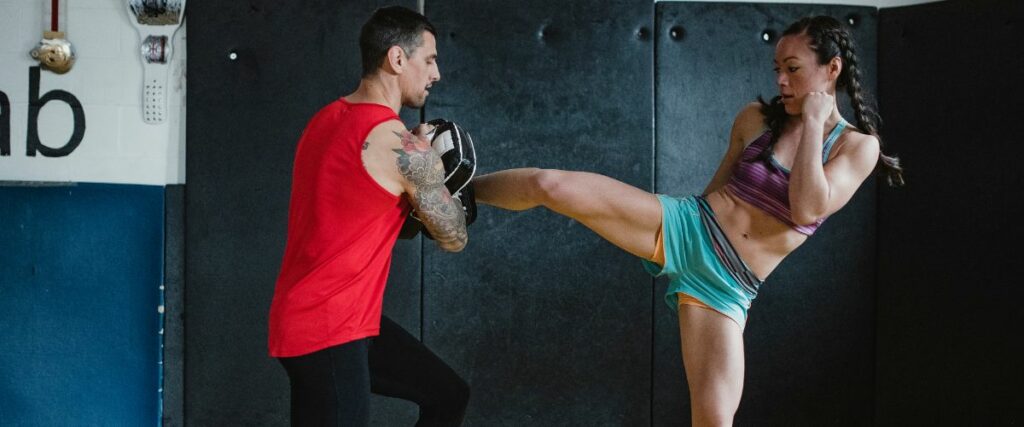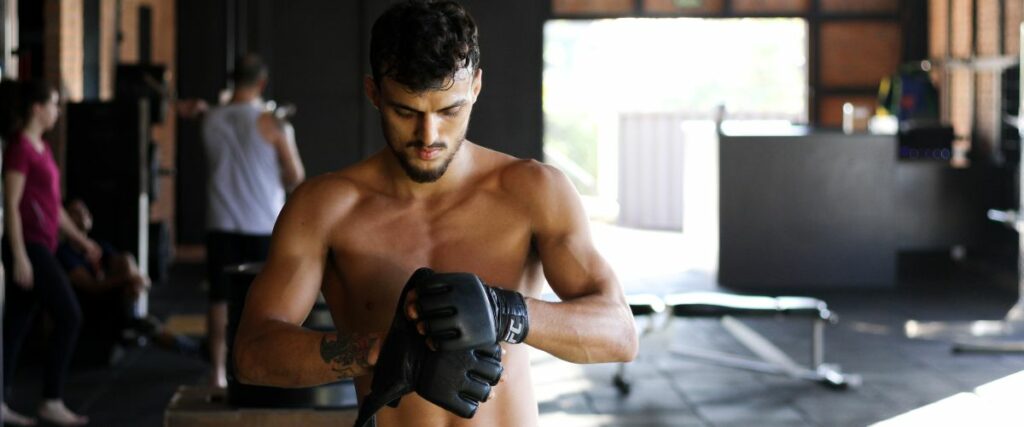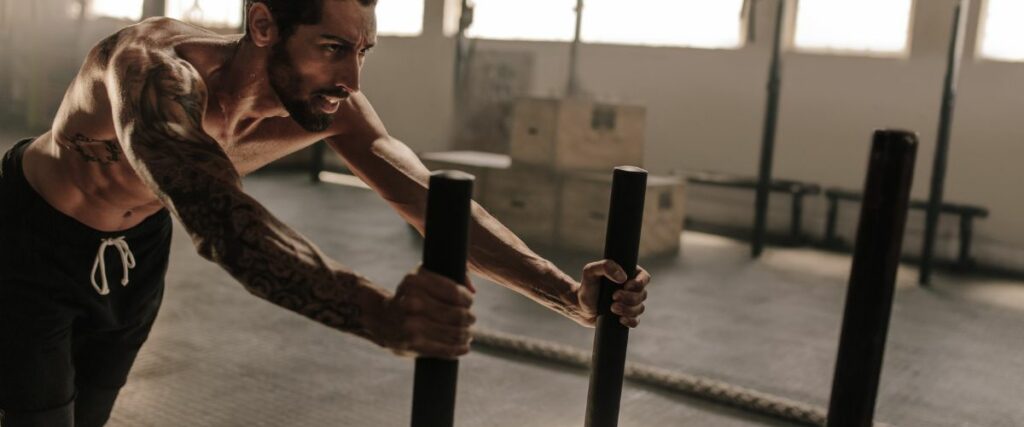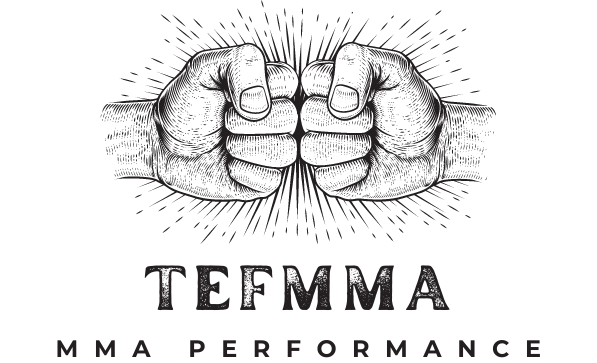MMA strength and conditioning have come a long way since the days of mindless circuits and random workouts. While this still happens within the community, well-thought-out MMA strength and conditioning programs have surfaced, allowing top MMA fighters to reach their potential.
A proper strength and conditioning routine will develop the physical qualities necessary to dominate your opponent through strength, speed, power, endurance, and longevity. Here’s how you can put together a strength and conditioning program for MMA.
What Strength & Conditioning Qualities Do You Need For MMA?
Strength
Strength is the ability to produce force. There are many forms of strength, such as maximal strength, starting strength, and reactive strength. All strength qualities are essential in MMA as strength underpins all other attributes.
That is, you can’t be powerful without first having a base level of strength. Strength is typically developed by lifting sub-maximal weights or lifting heavy weights slowly.
Power
Power is the product of strength and speed. It’s the ability to express rapid speeds with an external implement or your bodyweight. Jumping, throwing, sprinting, power strikes, and takedowns would be considered power-based movements.
Improving power comes down to enhancing either side of the power equation (strength or speed). So, you’re likely to become more powerful if you become faster or stronger. However, this isn’t always the case, as somebody who is brutally strong but can’t display speed won’t become more powerful by getting stronger.
A-lactic Power & Capacity

Development of the a-lactic energy system is often ignored. It’s frequently thought that you’re born speed and power, and you can’t train it. While it is highly genetic, it doesn’t mean you can’t become faster and more powerful with the proper training.
This is where many MMA fighters miss the mark. The a-lactic energy system supplies quick energy for very short bursts of explosive activity. Powerful shots, sweeps, and head kicks would be simple examples.
A-lactic power is trained by performing 6-10 seconds of maximum power exercise with complete recovery. A-lactic capacity uses slightly longer work intervals of 10-12 seconds with incomplete rest.
Anaerobic Glycolytic Power & Capacity
Anaerobic power and capacity are vital for powerful finishes in MMA. The Research by the UFC Performance Institute states, “77% of all UFC fights are ended in the 8-14 second high-intensity work period.”
Meaning you must be able to display tremendous speed and power and repeat it throughout a fight. Anaerobic power is developed with maximal to near-maximal intervals with near-complete rest.
Anaerobic capacity uses the same working interval intensities but incorporates incomplete rest, similar to most high-intensity interval training protocols.
Aerobic Capacity & Power
The importance of the aerobic energy system cannot be understated in MMA. Not only will a well-developed energy system improve your overall endurance, but it will help you recover faster between high-intensity efforts, rounds, fights, and training sessions.
A study in the Journal of Strength & Conditioning Research shows that winning MMA fighters increase their fight activity from round to round while losers reduce fight activity.
To become more active as the fight progresses, you need a substantial aerobic gas tank to sustain you over 3 x 5-minute rounds. Aerobic power is part of this equation and is an intensity around the lactate threshold.
Typical aerobic capacity training revolves around low-intensity, steady-state cardio. In contrast, aerobic power involves long sub-maximal intervals, typically with a 1:0.5-1 work to rest ratio.
Common MMA Strength & Conditioning Mistakes

Doing Non-Specific Circuits Until Fatigue
Conditioning isn’t only about the heart and lungs. Sure, you can run a marathon, cycle the Tour de France on your spin bike, or do battle rope and thruster circuits and get a great workout.
While there may be a time and place for non-specific conditioning, using these methodologies primarily won’t transfer to MMA performance.
Adaptations occur at the muscular and movement coordination level. Firstly, muscular adaptations like increased capillary density and mitochondrial volume enhance their ability to resist fatigue.
If you spend most of your conditioning time on a bike, these adaptations occur predominantly in the leg muscles leaving your upper body underdeveloped.
Secondly, movement efficiency plays a massive role in gassing out. That is why a runner who hits the pads for the first time can’t last one minute. While they may be aerobically fit for running, they aren’t for throwing hands.
Hence, prioritizing specific conditioning modalities will improve overall conditioning at the heart and muscular level plus improve movement efficiency.
Not Prioritizing High & Low Outputs
Many technical MMA training sessions are done at a moderate intensity. That is an intensity too low to stimulate increases in maximal speed and power and too high to recover from quickly. This is fine since the goal is technical mastery and part of the sport.
But when doing strength & conditioning outside of technical training, you often want to avoid this middle intensity. The reason is you don’t maximize speed, strength, and power development or build the aerobic base with low fatiguing exercise.
Further, you’re adding more of the same intensity on top of your skills training, so you don’t push the needle further to increase your cardio or become stronger and more powerful.
Going Too Hard Too Often

Hard training is a badge of honor within MMA. The harder you work, the less likely you will quit in a fight, correct? This old school of thought is slowly dying out within the MMA training world.
The problem with always going hard is two-fold:
- You can only recover from so much. It’s impossible to redline every session without something breaking.
- You miss lower intensity adaptations essential for overall MMA success.
There’s a time and place for strenuous workouts. They improve your ability to tolerate lactate so you can continue producing high power outputs at high heart rates. But this ability is built on a foundation of low-intensity cardio.
Not Resting Long Enough Between Sets
Lifting weights is for developing strength, speed, and power, not mimicking fight intervals. That means 2-5 minutes of rest between every set, depending on the exercise. Complete rest means maximizing power outputs for every set, making you more powerful in the cage.
Using Bodybuilding Programs For Strength Training
It’s easy to find a body part split on the internet and follow a 5-day per week weight training routine. The problem is training muscle groups purely for hypertrophy and not movements to develop strength and power limits the transfer to MMA.
Further, the volume in these programs is typically astronomically high, causing recovery problems. Think about blasting 15 sets of legs and then trying to shoot takedowns the following day.
Best MMA Strength Exercises
Power Exercises
Power exercises are intended to move light to moderate loads quickly. They can also be bodyweight exercises if you are short on equipment. Here are a couple of examples:
Trap Bar Jump
You can perform the trap bar jump from the floor or with a countermovement like a vertical jump. The first variation, as shown in the video, develops concentric only power without the need for an eccentric stretch.
The second variation uses a countermovement, improving elastic abilities and reactive strength. Both are important to the sport of MMA.
Box Jump
The box jump is a simple bodyweight power exercise for vertical force production. Like the trap bar jump, it will transfer to improving punching power. The box jump shown in the video is a straight leg box jump which emphasizes jump height instead of how high you can tuck your legs.
Squat Exercises
The squat is a fundamental movement for MMA strength development. It will develop a stable and strong base to transfer to powerful strikes and shots.
Back Squat
The back squat is a staple exercise in most programs. You don’t have to stick to the back squat, however. There are many alternatives, such as front squats and safety bar squats. The back squat and safety bar squat are better for overall strength development since you can handle heavier loads.
Zercher Squat
The Zercher squat is becoming more popular within MMA. It doesn’t tax the legs like other squat variations. Still, it provides a great stimulus for upper body isometric strength that can transfer to grappling.
Hip Hinge Exercises
A hip hinge differs from a squat, where the movement predominantly occurs at the hips instead of the knees. Therefore, you target the muscles behind the body necessary for maintaining posture when grappling.
Deadlift
I like the trap bar deadlift better for MMA as there’s less lower back involvement which can take a beating in technical training. However, the straight bar deadlift is still an excellent option for building full-body strength.
Romanian Deadlift
You should use the Romanian deadlift more often within MMA strength training. The ability to support heavy loads with the back, glutes, and hamstrings will develop a strong base.
Upper Body Push Exercises
Upper body strength is vital for striking and grappling exchanges but developing the upper body pushing muscles also provides body armor against strikes.
Bench Press
Every MMA fighter has likely bench pressed. It’s the upper body pressing exercise you can load the heaviest, leading to rapid strength gains. Avoid doing super wide grip bench presses and stick to a closer grip.
Overhead Press
Not all fighters can get into an overhead position safely, especially with rounded shoulder postures from years of striking. But it’s essential to find these positions for overall shoulder health.
Upper Body Pull Exercises
MMA is a sport predominately performed with the arms being pushed in front of the body. Therefore, it’s crucial to develop the pulling muscles for structural stability and strength when grappling.
Chin-Up
You can do the chin-up with an underhand or overhand grip known as the pull-up. Mix it up between workouts or training cycles. With will keep your elbows healthy too. As these get too easy, strap some weight around your waist for unreal upper body pulling strength development.
Barbell Row
The barbell row challenges your ability to isometrically hold a bent-over position which can be important during grappling scenarios. Further, upper body pulling strength will transfer to clinching and body locking.
Single-Leg Squat Exercises
Single leg work is important to reduce asymmetries between legs. Further, it takes a fighter out of a typical up and down motion with the feet next to each other. Staggering the feet or moving to the side can provide a holistic performance program.
Bulgarian Split Squat
Because the leg is supported and you are stationary, the Bulgarian split squat is a big bang for your buck single-leg exercise. The bonus is the stretch it places on your back leg hip flexors, increasing your hip range of motion.
Hand Supported Split Squat
The hand-supported split squat is the most brutal single-leg variation because you can lift similar loads to bilateral squat variations. To do this safely, you need a safety squat bar and handles attached to a power rack.
Single-Leg Hip Hinge Exercises
Single-leg hip hinge exercises are used for the same reason as single-leg squat exercises. They provide balance between the legs.
Single-Leg Romanian Deadlift
The best way to perform the single-leg Romanian deadlift is by holding a dumbbell or kettlebell in the opposite hand to the stance leg. This acts as a counterbalance. A bonus with this exercise is how well it strengthens the feet.
Single-Leg Hip Thrust
Preferentially targeting the glutes for horizontal force production is limited to exercises like the single-leg hip thrust. There’s less overall fatigue using the hip thrust vs. deadlifting. You can load this with a dumbbell or sandbag.
Carry Exercises
Carries come from the Strongman world and have great carry-over to grappling exchanges. They develop vicious grip, arm, and back strength in positions similar to holding another fighter.
Farmers Walk
The farmers walk will build full-body strength other exercises can’t. From your fingers to your legs, the farmers walk transfers to being stronger in grappling exchanges developing the core, back, and grip.
Sandbag Bearhug Carry
The sandbag bearhug carry is excellent for strengthening the body lock or double under position when grappling. Especially if you like to pick up your opponent to slam onto the canvas. You can use the same grips you use when fighting, such as the S grip, Gable grip, or hand over the wrist.
Core Exercises
The core is how force is transferred from the legs to the upper body. Developing strength in different exercises will help transfer this force.
Ab Wheel Rollout
The ab wheel was probably the most useful infomercial product for fitness. It’s considered an anti-extension core exercise that challenges your posture not to collapse when extending the arms in front.
Band Rotation
MMA is a rotational sport. Strikes, throws, and takedowns all have a rotational element. You can do the band rotation explosively or slowly with a heavy band.
Upper Body Isolation Exercises
Isolation exercises are usually used by people trying to gain muscle. While they serve this purpose, they also allow you to train muscles that don’t get trained during larger movements and for overall injury reduction.
Bicep Curls
Big guns look great. But bicep curls strengthen the arms for grappling scenarios, especially when pummelling, body locking, and clinching. Further, it’ll help with overall elbow health.
Rear Delt Reverse Fly
The rear delts don’t get much love even with overhead pressing and rows. For shoulder health, it’s crucial to target the rear delts to balance the front, side, and rear delts.
Dominate The Cage MMA Strength Training Program ↗
Jon Jones got it wrong. Powerlifting and Bodybuilding programs don’t work for MMA. Use a training program designed specifically for MMA instead.
Underground MMA Conditioning System↗
If you’re spending hours outside of MMA training and not feeling any “fitter,” the Underground MMA Conditioning System was designed for you! Individual conditioning prescription based on your fitness level.
MMA 2-Day Strength Training Routine
Here is how you can piece these exercise categories into a 2-day MMA strength training program.
Day 1
1. Power Exercise
2. Squat Exercise
3a. Upper Body Push Exercise
3b. Upper Body Pull Exercise
4. Single Leg Hip Hinge Exercise
5. Carry
6a. Core
6b. Upper Body Isolation Exercise
Day 2
1. Power Exercise
2. Hip Hinge Exercise
3a. Upper Body Pull Exercise
3b. Upper Body Push Exercise
4. Single Leg Squat Exercise
5. Carry
6a. Core
6b. Upper Body Isolation Exercise
MMA 3-Day Weight Training Routine
If you are further away from fight camp, you can be in the gym three times per week if it is your weakness.
Day 1
1. Power Exercise
2. Squat Exercise
3. Upper Body Pull Exercise
4. Carry
Day 2
1. Single Leg Squat Exercise
2. Single Leg Hip Hinge Exercise
3. Upper Body Push Exercise
4. Upper Body Pull Exercise
5a. Core Exercise
5b. Upper Body Isolation Exercise
Day 3
1. Power Exercise
2. Hip Hinge Exercise
3. Upper Body Push Exercise
4. Carry
MMA Conditioning Routine
We can’t forget MMA conditioning within your training week. Treat these as a plug-and-play where you add what you need depending on the type of training day.
Aerobic Capacity
Option 1 – Low intensity, steady-state cardio. 30-60 minutes with a maximum heart rate of 180 – age. E.g., 180 – 25 = 155 beats per minute maximum heart rate. Best heart rate range between 120 – 150 BPM or a pace you can do while only nasal breathing.
Option 2 – Low-intensity MMA-specific circuit. Same parameters as above but using MMA techniques. Shadowboxing, shadow wrestling, bag work, grappling dummy, etc. Perform in a circuit fashion. E.g., 5 min shadow boxing, 5 min shadow wrestling, etc.
Aerobic Power
Option 1 – Threshold intervals with specific MMA techniques. 4 x 5 min w/2.5 min rest at anaerobic threshold (approximately 165-175 BPM).
Option 2 – Threshold intervals with off-feet cardio equipment. 10 x 40 sec w/ 20 sec rest.
Anaerobic Glycolytic Power
Option 1 – Maximal power shots on the bag. 3 x 20 sec maximal intensity w/ 3 min rest.
Option 2 – Near maximal off-feet cardio. 3 x 40 sec w/ 3 min rest.
Anaerobic Glycolytic Capacity
Option 1 – Near maximal strikes and shots. 4 x 90-sec w/60-sec rest.
Option 2 – Near maximal off-feet cardio. 8 x 30 sec w/ 30 sec rest.
A-Lactic Power
Option 1 – Power shots on bag. 6 x 6 sec w/ 2-3 mins rest.
Option 2 – Off-feet cardio sprints. 6 x 7 sec w/ 2-3 mins rest.
A-Lactic Capacity
Option 1 – Power shots on bag. 10 x 10 sec w/ 45 sec rest.
Option 2 – Off-feet cardio sprints. 10 x 10 sec w/ 10 sec rest.
Frequently Asked Questions About MMA Strength & Conditioning Programs
Is Strength Training Good For MMA?
Strength training is great for MMA and should be a staple in all fighter’s training routines. It will help during hard grappling exchanges, improve your striking power, increase your ability to tolerate workloads, and reduce your risk of injury.
How Many Times A Week Do MMA Fighters Lift Weights?
MMA fighters will typically perform 2-3 weight lifting sessions per week depending on the stage of their fight camp and their weaknesses. Coming off a fight with plenty of time until the next fight, MMA fighters may lift weights 3 times per week if strength, size, or power are a weakness.
As an MMA fighter gets closer to a fight (e.g., an 8-week fight camp), lifting weights will drop to twice a week to preserve energy for more intense technical training.
Do MMA Fighters Need To Lift Weights?
MMA fighters don’t need to lift weights, but you definitely should. You’ll put yourself at a considerable disadvantage when coming up against stronger opponents when grappling. Further, lifting weights does more than develop strength.
When done correctly, you can reduce your risk of injury, increase your tolerance to high training loads, and generate more power in your strikes and takedowns.
Summary
MMA strength and conditioning requires thorough planning and applying the principles laid out in this article. Many make the mistake of trying to replicate MMA “toughness” within their strength and conditioning programs. Unfortunately, this will not maximize MMA performance and will undercook you on fight day.
If you need help with a done-for-you program, my friend and expert strength & conditioning coach James de Lacey at Sweet Science of Fighting has put together an epic MMA strength and conditioning program you can do without having to do any programming yourself.
Further, it’s all options-based, so you can select the exercises that suit your equipment availability or injury history.
Dominate The Cage MMA Strength Training Program ↗
Jon Jones got it wrong. Powerlifting and Bodybuilding programs don’t work for MMA. Use a training program designed specifically for MMA instead.
Underground MMA Conditioning System↗
If you’re spending hours outside of MMA training and not feeling any “fitter,” the Underground MMA Conditioning System was designed for you! Individual conditioning prescription based on your fitness level.
References
1. Miarka, B., Vecchio, F. B., Camey, S., & Amtmann, J. A. (2016). Comparisons: technical-tactical and time-motion analysis of mixed martial arts by outcomes. Journal of strength and conditioning research, 30(7), 1975-1984.
